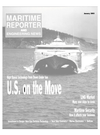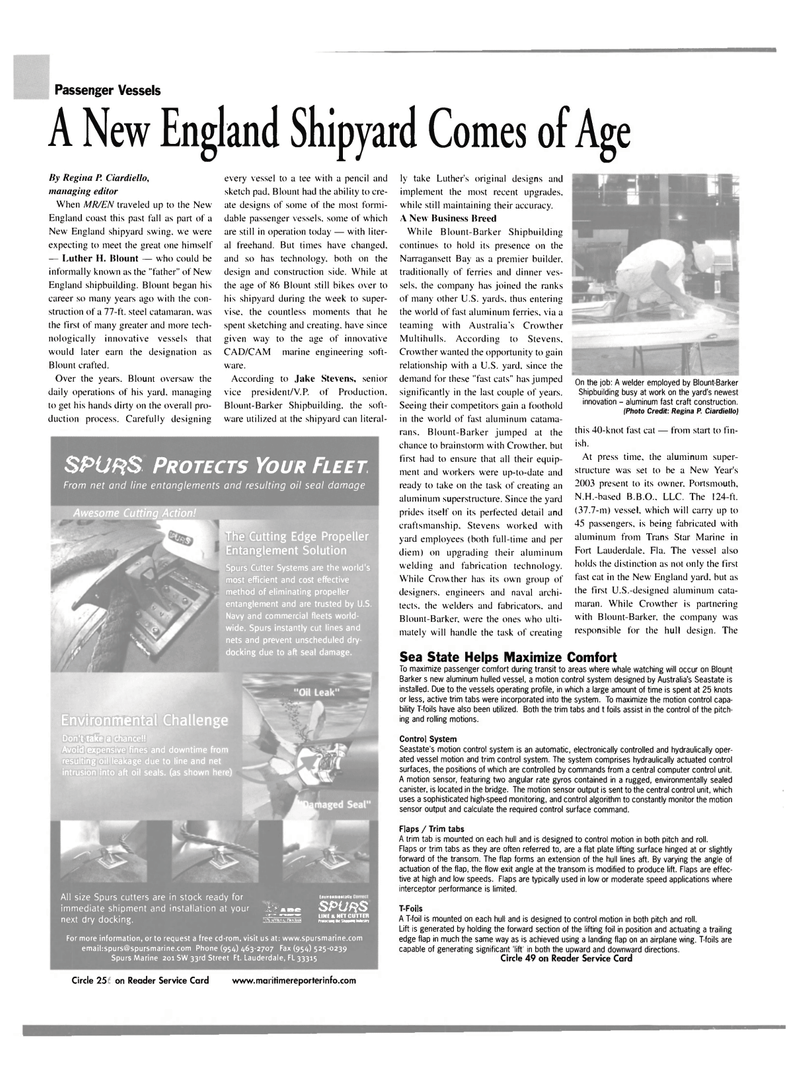
Page 32: of Maritime Reporter Magazine (January 2003)
Read this page in Pdf, Flash or Html5 edition of January 2003 Maritime Reporter Magazine
Passenger Vessels
A New England Shipyard Comes of Age
By Regina P. Ciardiello, managing editor
When MR/EN traveled up to the New
England coast this past fall as part of a
New England shipyard swing, we were expecting to meet the great one himself — Luther H. Blount — who could be informally known as the "father" of New
England shipbuilding. Blount began his career so many years ago with the con- struction of a 77-ft. steel catamaran, was the first of many greater and more tech- nologically innovative vessels that would later earn the designation as
Blount crafted.
Over the years. Blount oversaw the daily operations of his yard, managing to get his hands dirty on the overall pro- duction process. Carefully designing every vessel to a tee with a pencil and sketch pad. Blount had the ability to cre- ate designs of some of the most formi- dable passenger vessels, some of which are still in operation today — with liter- al freehand. But times have changed, and so has technology, both on the design and construction side. While at the age of 86 Blount still bikes over to his shipyard during the week to super- vise, the countless moments that he spent sketching and creating, have since given way to the age of innovative
CAD/CAM marine engineering soft- ware.
According to Jake Stevens, senior vice president/V.P. of Production.
Blount-Barker Shipbuilding, the soft- ware utilized at the shipyard can literal- ly take Luther's original designs and implement the most recent upgrades, while still maintaining their accuracy.
A New Business Breed
While Blount-Barker Shipbuilding continues to hold its presence on the
Narragansett Bay as a premier builder, traditionally of ferries and dinner ves- sels. the company has joined the ranks of many other U.S. yards, thus entering the world of fast aluminum ferries, via a teaming with Australia's Crowther
Multihulls. According to Stevens.
Crowther wanted the opportunity to gain relationship with a U.S. yard, since the demand for these "fast cats" has jumped significantly in the last couple of years.
Seeing their competitors gain a foothold in the world of fast aluminum catama- rans, Blount-Barker jumped at the chance to brainstorm with Crowther, but first had to ensure that all their equip- ment and workers were up-to-date and ready to take on the task of creating an aluminum superstructure. Since the yard prides itself on its perfected detail and craftsmanship, Stevens worked with yard employees (both full-time and per diem) on upgrading their aluminum welding and fabrication technology.
While Crowther has its own group of designers, engineers and naval archi- tects. the welders and fabricators, and
Blount-Barker. were the ones who ulti- mately will handle the task of creating
On the job: A welder employed by Blount-Barker
Shipbuilding busy at work on the yard's newest innovation - aluminum fast craft construction. (Photo Credit: Regina P. Ciardiello) this 40-knot fast cat — from start to fin- ish.
At press time, the aluminum super- structure was set to be a New Year's 2003 present to its owner, Portsmouth,
N.H.-based B.B.O.. LLC. The 124-ft. (37.7-m) vessel, which will carry up to 45 passengers, is being fabricated with aluminum from Trans Star Marine in
Fort Lauderdale. Fla. The vessel also holds the distinction as not only the first fast cat in the New England yard, but as the first U.S.-designed aluminum cata- maran. While Crowther is partnering with Blount-Barker, the company was responsible for the hull design. The
SPURS PROTECTS YOUR FLEET
From net arid line entanglements and resulting oil seal damage
Sea State Helps Maximize Comfort
To maximize passenger comfort during transit to areas where whale watching will occur on Blount
Barker s new aluminum hulled vessel, a motion control system designed by Australia's Seastate is installed. Due to the vessels operating profile, in which a large amount of time is spent at 25 knots or less, active trim tabs were incorporated into the system. To maximize the motion control capa- bility T-foils have also been utilized. Both the trim tabs and t foils assist in the control of the pitch- ing and rolling motions.
Control System
Seastate's motion control system is an automatic, electronically controlled and hydraulically oper- ated vessel motion and trim control system. The system comprises hydraulically actuated control surfaces, the positions of which are controlled by commands from a central computer control unit.
A motion sensor, featuring two angular rate gyros contained in a rugged, environmentally sealed canister, is located in the bridge. The motion sensor output is sent to the central control unit, which uses a sophisticated high-speed monitoring, and control algorithm to constantly monitor the motion sensor output and calculate the required control surface command.
Flaps / Trim tabs
A trim tab is mounted on each hull and is designed to control motion in both pitch and roll.
Flaps or trim tabs as they are often referred to, are a flat plate lifting surface hinged at or slightly forward of the transom. The flap forms an extension of the hull lines aft. By varying the angle of actuation of the flap, the flow exit angle at the transom is modified to produce lift. Flaps are effec- tive at high and low speeds. Flaps are typically used in low or moderate speed applications where interceptor performance is limited.
T-Foils
A T-foil is mounted on each hull and is designed to control motion in both pitch and roll.
Lift is generated by holding the forward section of the lifting foil in position and actuating a trailing edge flap in much the same way as is achieved using a landing flap on an airplane wing. T-foils are capable of generating significant 'lift' in both the upward and downward directions.
Circle 49 on Reader Service Card
Awesome Cutting Action!
The Cutting Edge Propeller
Entanglement Solution
Spurs Cutter Systems are the world's most efficient and cost effective method of eliminating propeller entanglement and are trusted by U.S.
Navy and commercial fleets world- wide. Spurs instantly cut lines and nets and prevent unscheduled dry- docking due to aft seal damage.
Environmental Challenge
Don't take a chance!!
Avoid expensive fines and downtime from resulting oil leakage due to line and net intrusion Into aft oil seals, (as shown here)
All size Spurs cutters are in stock ready for «"*•••••"«» immediate shipment and installation at your SPURS
J„,l.:„„ UNI ft NET CUTTER next dry docking. rm.cimiKSKwmiin.im
For more information, or to request a free cd-rom, visit us at: www.spursmarine.com email:[email protected] Phone (954) 463-2707 Fax (954) 525-0239
Spurs Marine 2015W 33rd Street Ft. Lauderdale, FL 33315
Circle 254 on Reader Service Card or visit www.maritimereporterinfo.com

 31
31

 33
33
